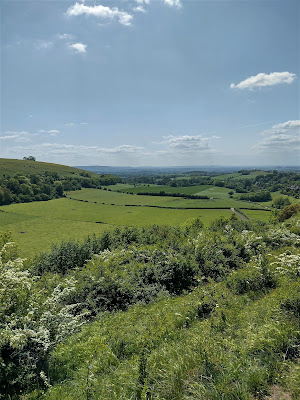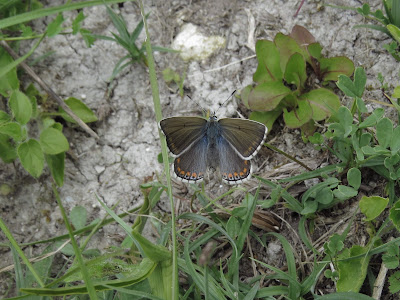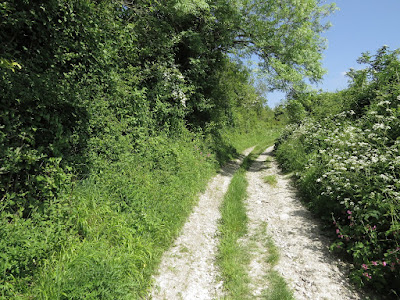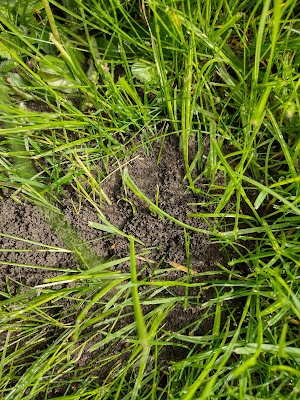As one William Shakespeare said “We will all laugh at gilded butterflies.”
Of course the Bard was referring to superficially beautiful beings with no substance or purpose. Whereas as I have a week's leave and as the weather has turned sublime I am purposefully on the quest for Mr Vernon's Small Fritillary. Or as it is now known, the Duke of Burgundy butterfly.
I had to look it up. I came to this part of Dorset in the spring of 2013. Then I was with Richard Fox from Butterfly Conservation and the irrepressible presenter Dylan Winter. We were here to record a piece for the Radio 4 series Shared Planet and this particular episode I produced had as a theme Fragility and Niche. Which was why a decade ago we had arrived at the Cerne Abbas Giant Hill to record a field piece to illustrate the precariousness of species survival in a crowded human landscape.
[The episode is still available on line here : https://www.bbc.co.uk/programmes/b03dsk4n ]
At the time we saw a few Dukes, all found by Richard, but it surprised me then how small they were. A grandiose name for a very small butterfly.
The act of producing a programme essentially involves becoming an expert on a subject for a week then forgetting everything. Midway between these points there will be a recording usually on location. As the producer I'd be there but concentrating on what people are saying through headphones rather than being fully involved with the surroundings or what's happening. Once recording is over I'd then head back to the office, no time to stop. I vowed then to come back to this hill and, without editing timescales or deadlines, to look for Dukes myself in a leisurely way. That vow somehow took a decade to be realised but on Monday May 22nd 2023 I arrived with my camera, a small picnic and the excitement of exploring a huge hillside better known for its outrageously fertile giant.

Oddly it is virtually impossible to see the Giant carved into the chalk from the hill itself. The climb begins by crossing the river Cerne over the 14th century Kettle Bridge, then through a lovely old gate and into a small wooded area before a number of steps up onto the lower slopes, which on my visit opened out from the trees into a vista of chalk downland on a hot sunny spring day. Expectations were high.

The one thing I did remember from the programme was that the Duke of Burgundy's natural habitat is coppiced woodland and they were once widespread across England. With the demise of coppicing their population declined rapidly so now they are a threatened species in Britain. As a result Dukes were forced to adapt to a lesser habitat of mostly southern England chalk downland and short grassland at a few other locations. Lesser in that the primrose and cowslips on the downland are prone to drying out in the summer exactly when the larvae need that for food, though with climate change they may benefit from warmer and damper summer weather.
Previously the adults would fly in sheltered sunny woodland glades and therefore on this grassland they will only be found on the lower sheltered slopes, near the cowslip and primrose the larvae need, and tussocky grass from which the males fly up to defend their territory. I'd also remembered that the best sightings on this site were further away from the entrance. Time for a walk then.
The first few butterflies encountered were a tatty tortoiseshell and quite a few common blues which were proving impossible to photograph, not helped by the gusty wind. This was a minor inconvenience as being on this hillside was an uplifting experience. Only a couple of other butterfly watchers about but on this Monday morning it was quiet, other than the incessant call of a yellowhammer which was a particular highlight, as was the hawthorn blossom. All across the West Country this year, and maybe elsewhere, hawthorn blossom has been the best I've ever known it. I'm assuming the cold snap we had delayed bud burst which then, when the sun emerged a week or so back, synchronised everything and the hedges, fields and hills looked as if they were dotted with snow white pom-poms - a spectacular sight providing dazzling delight in the sun. But back to the butterflies.

If I'm truthful I will admit to not being a butterfly expert in any sense. Yes I can identify a number of species but know precious little of their ecology. And that's a shame, as there are under 60 regular species in the UK. How much I have missed out not learning about so few species. As my week's leave approached my plans changed and so I decided to rectify this lack of butterfly knowledge and spend a few days in Dorset simply watching and learning, and in doing so I made my first error.
Initially I thought the two images below were female common blue - I'd read the books. Common blue male looks blue and female looks brown (I've simplified this a little). I'd seen a lot of common blues on the sheep track to find the Dukes, taking many images as I slowly walked along, and my mind said common blue female. However later in the evening going through my ID guide, I'm reliably informed (and will be chastised by readers) this is a brown argus. I thought it showed too much blue on the body for an argus, but working all this out has somehow got me hooked, I need to know more.
Saying that, I could identify the male common blue (below) and a handful of the other species wafting by in the breeze today, speckled wood, large white, orange tip and brimstone which were reasonably abundant by the hedge at the bottom of the hill, as was a single red admiral.
However on the short grassland I kept seeing small beautifully marked butterflies, some brilliantly so, others more subdued. Suddenly deep in the recesses of my brain the words skipper came to me. I've seen these before with others more knowledgeable but I'd not really properly taken in what they looked like. On my visit there were two species on the wing, dingy, on the left here, and grizzled, on the right. What lovely little butterflies they are and being so abundant I could study the marking and the behaviours with a relaxed air of one who knows - absolutely nothing. They loved perching on the salad burnet.

And yet, much as this was entertaining I had come to see a Duke. Walking to where I thought the Dukes may be I had a conversation with a proper lepidopterist - binoculars, baggy shorts, big camera and a khaki floppy hat. He pointed me to roughly where to go and also told me they were on the wing. I now knew they were flying, but there's no guarantee of that even this late in May, their normal flying period, especially this year after this cold spring has held a lot of emergence back. He also let me know that up on Telegraph Hill (a private access reserve opposite the Giant) they'd counted 20 on a field trip the previous Saturday. He suggested between 4 and 6 were on the Cerne Hill today - not many then in this vast landscape. One would be enough for me, and in the end I found two - possibly a third but that may have been one of the other two returning.
I now found myself about half way along the hillside and below me a really sheltered spot between low shrubs and bramble there lay a grassy area, which on closer inspection looked trampled - possibly by lepidopterist feet. Down I went. Initially nothing moved other than an orange tip and a whacking big hornet. It was getting really hot now so I sat down and had some of my picnic. It was at this point a Duke shot past. I knew instantly it was what I'd come to find and although it then disappeared I found myself silently whooping for joy. I sat a bit longer and after ten minutes it returned and alighted on a buttercup, to then be joined by another which caused a rumpus and they spiralled into the air and away.
Eventually one came back and alighted on a grassy tussock. Having observed it for a while I tried to take a photograph, at which point it flew off. And this was the cat and mouse chase we danced for the next half an hour, until I finally managed a half decent image. I was overjoyed and what a beautiful insect, though I never saw the two together again.
Having mentioned the Duke's previous name in the radio programme I'd produced, I did some reading up on this species discovering that it was in the 1700's that this butterfly was first named Mr. Vernon's Small Fritillary after the man who found it. I've yet to discover much about Mr William Vernon who was a serious collector under the patronage of Sir Hans Sloan and one James Petiver. Vernon travelled to Europe and the United States and sent specimens back for identification, by Petiver and interestingly John Ray who is often quoted as the father of natural history and igniting modern ecology.
The first printed reference to this earlier name was in 1699 within James Petiver's book (published between 1695-1703) Musei Petiveriani centuria prima-decima, rariora naturae continens (a systematic catalogue of wildlife). Petiver was a member of the gloriously named Temple Coffee House Botany Club near Fleet Street in London, which at the time was a meeting house for those who studied, and traded in botany and entomology. Sometime in the early 1800's the name was changed to the Duke of Burgundy fritillary. Why the change is debated still, today however as this butterfly is not a fritillary, it is simply know as the Duke of Burgundy. I've digressed again.
I decided to leave the Duke to its habitat and head off and to be honest the rest of the walk along the base of the hill was quite uninspiring butterfly wise, though I did spot this which I am to believe is the day-flying Mother Shipton moth. A nice cinnabar moth effectively ended my visit here.
It was getting really warm on that hillside on my way back so I stopped for a while to finish off my picnic, simply to take in the view. The wind was quite strong now, presumably temperature related and enhanced by the slope, meaning there was little if anything flying now other than more dingy and grizzled skipper. Somewhere also a song thrush sang continuously. It was a great end to a momentous day. Little was I to know then I'd return in 48 hours.
Dingy skipper
Grizzled skipper underwing and topside below

Having got home in the evening on Monday and spoken about the joy of finding my first Duke, Mrs Wessex Reiver reminded me she had a day free on Wednesday and she'd like to see them and go for a walk. And that's what we did. I had one quest that Wednesday to try and take a better photograph of the Duke, then go for a walk. On this second visit we didn't get to the hill until nearly 1 pm and had the place almost to ourselves, which is amazing for a worldwide tourist spot. Following on from Monday's encounter I went straight to the place I'd seen the Duke, and to my amazement one arrived minutes after we'd sat down to wait. Repeatedly this individual settled, flew off and returned to the same area, onto his tussock of grass for a good twenty or thirty minutes. So tame was he that both Mrs Wessex Reiver and I sat down next to it and watched all his activity close to. What an absolute privilege to see one of Britain's rarest butterflies so intimately.


It was time to say our goodbyes and off we went up the hill. I've never walked up the Giant's hill but the views are superb and it was a good release of pent up adrenalin to not be staring in awe at the Duke.
Path on the left up from the hill bottom and then along the ridge towards camera
Wonderful Dorset views from the Wessex Ridgeway
The Giant is now fenced off. And that drop was STEEP!
It is hard to describe the moment this week that I realised that watching butterflies in baking heat really appeals to me. I used to record radio programmes involving the great butterfly man Matthew Oates and he said to me once why he watched butterflies.
"With birds you have to get up before dawn and crash about in the half light to get the best views and remain still and silent. With butterflies I can have a leisurely breakfast, head off mid morning, maybe sit on a hill, or in a woodland in a deck chair with bottle of wine if observing purple emperors, or listen to the cricket test matches on a portable radio while slowly walking along watching butterflies, before then returning home in time for an early tea"
I think I have reached an age where sitting with a glass of wine observing wildlife is quite appealing. It has me hooked and what I didn't know on that Wednesday was that on the following day I'd return to Dorset on my own and see over 100 Adonis blue along one track. That however is for a future posting.









































.jpg)















